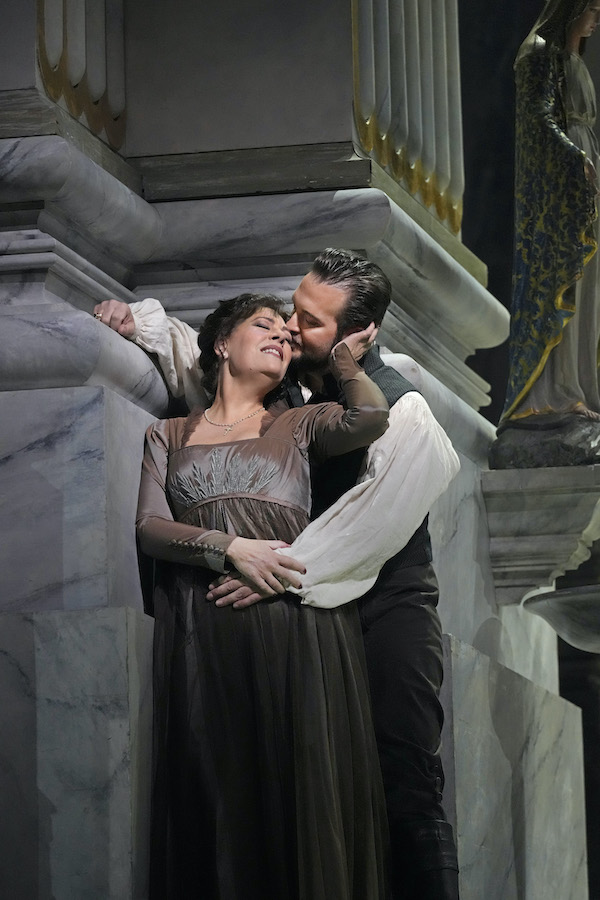Radvanovsky’s memorable portrayal lifts Met’s “Tosca”

The Metropolitan Opera’s revival of Tosca will run in segments for the next few months, featuring three different singers in the title role. Thursday night’s opening in the Metropolitan Open House proved a showcase for the first of these, soprano Sondra Radvanovsky.
The evening was all about Radvanovsky, even beyond the role she played. Flanked by tenor Brian Jagde as Cavaradossi and bass-baritone George Gagnidze as Scarpia—and with music director Yannick Nézet-Séguin leading the orchestra—it was Radvanovsky who was almost entirely responsible for the successes of the evening’s performance. When she was on stage, everything was vivid and vital. When she was not, the experience quickly turned lackluster.
Jagde was a mismatch, at least on stage, as Tosca’s lover, the painter Cavaradossi. His voice was strong and clear from his first notes, but his performance was on the plain and stiff side. Each note was correct, but their quality sounded not much distant from reading the part in a rehearsal. There was physical energy in his singing but little characterization, the music not adding up to anything deep about Cavaradossi’s thoughts. His first act juxtaposition with the Sacristan (bass-baritone Patrick Carfizzi, who was lively and charming) was an unexpected contrast between an acceptable, but four-square approach, and the kind of phrasing that expresses character, with slight but important variations in tempo, dynamics, and articulation.
Replacing an ailing Yevgeny Nikitin, Gagnidze was a fine Scarpia, imposing but not hammy. There was an inner life and drive to his singing as well, and this showed in contrast in his scenes with Jagde. While the tenor continued to outline his part, even in the crucial Act 2 confrontation, Gagnidze embodied the character’s sociopathic assurance. Scarpia sees Tosca as a social inferior that he can manipulate and dominate, and Gagnidze carried off that elitist disdain in his singing, with a bit of bravado and self-involvement.
The crowd was primed for Radvanosky, breaking into applause at her very first appearance on stage before she sang a note, like in the early 20th century. Her voice was the clearest and most powerful all night, with shine and heft. Far beyond the technical aspects, her singing was the most expressive and meaningful music-making of the evening, not just compared to the other singers but to the orchestra.
In less expert hands, the title diva can become cartoonish, an embodiment of the shallowest clichés about opera and opera culture, with death as the inevitable end point of love. Yet Radvanovsky gave the character complete, realistic, sympathetic, and expressive life. This was grounded in her sound production, every note vibrating with passion, singing with a volume and carry that was on its own level. From this, she used a flow of rubato, dynamic levels, and fluid articulation to turn the mercurial nature of the character into music.
Nothing works in Tosca unless the character’s love for Cavaradossi and her uncontrollable jealousy seem genuine, and Radvanovsky made them both searingly real. In the first act, the swing between these two, triggered by Cavaradossi’s painting, was vivid, her love calm and mellow, her jealousy spiky and brittle.
The fire and emotional power of the soprano’s “Vissi d’arte” was a genuine tour de force, showing how Radvanovsky’s beautiful dark tone could wring a harrowing dramatic experience out of Puccini’s graceful melody. The crowd, seemingly waiting all night for this moment, erupted in an exuberant ovation that went on for many minutes. In Act 3, it was her singing that drove the climax—one became impatient during the instrumental prelude and Jagde’s pedestrian “E lucevan le stelle” for Tosca’s reappearance.
But Tosca is not always on stage, and even the orchestra was diminished by Radvanovsky’s absences. The stretch of music after she departs the church in Act 1 and before the Te Deum was sluggish, like the air had gone out of the pit with her exit.
Nézet-Séguin made up for this with perhaps the loudest Te Deum ever heard at the Met—quantity was its own quality, though not necessarily a good one. In Act 2, there was only mild tension coming from the conducting in the exchanges between Cavaradossi and Scarpia, which should crackle. The Act 3 prelude can be as emotionally powerful and complex as any vocal moment in the opera, and Thursday night it sounded incidental.
This was a problem with the instrumental music-making, which was surprisingly flat all night. The pace and tempo were unobjectionable, but the range of expression was narrow—rounded foothills rather than Puccinian peaks.
The score is full of details that further the drama, things like a switch in the instrumental range and color to change a mood, or a sudden rushing gesture to prepare a critical moment. Yet most of these came out of the pit without sufficient impact or even an indication that there might be a dramatic purpose behind the notes. David McVicar’s realistic, literal production, is full of polished details, but still one should be gripped more by the music than by how many wine glasses Scarpia has on his table.
Later performances of Tosca will feature sopranos Elena Stikhina and Aleksandra Kurzak, who should also elicit high expectations. But this month, Sondra Radvanovsky alone is reason enough to see this revival.
Tosca runs through March 12, 2022. metopera.org